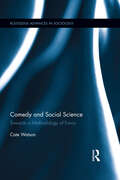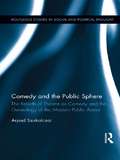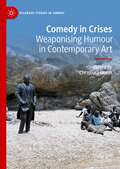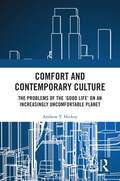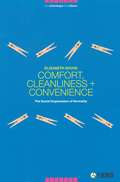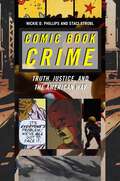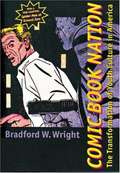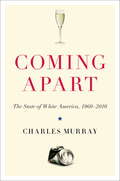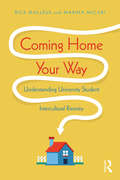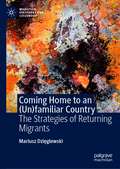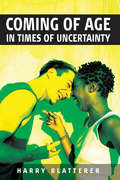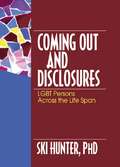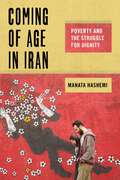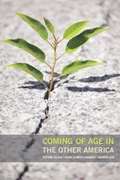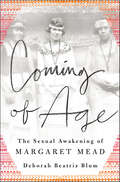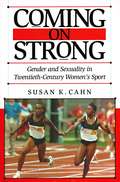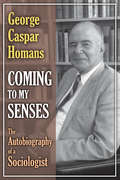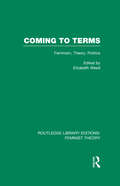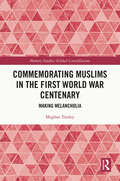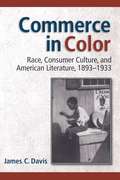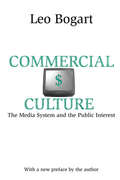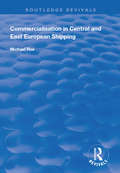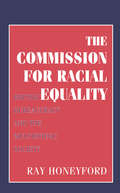- Table View
- List View
Comedy and Social Science: Towards a Methodology of Funny (Routledge Advances in Sociology #153)
by Cate WatsonWhile there have been many sociological and psychological studies of humor, few can claim to be funny. Humor may be regarded as a legitimate topic for social scientists, but in general, they present their research rather seriously. In academia, humor tends to be trivialized and dismissed. This is more than just a missed opportunity for otherwise fun-loving academics. In literature, it is readily accepted that comedy is integral to the human condition. To ignore humor is to reject a potentially insightful methodological approach, as the humorous worldview presents unique opportunities for investigating the social. This book constitutes a unique resource, presenting chapters on irony, satire and parody as tools for analysis and means of representation, as well as considering humor in the conduct of research, and offering guidance on getting published. Through presenting examples from across the social sciences, the book seeks to persuade and inspire rather than to prescribe an approach – a closure which would (ironically) be inimical to the multiplicity and ambiguity which characterizes humorous research and lends it its distinctive edge.
Comedy and the Public Sphere: The Rebirth of Theatre as Comedy and the Genealogy of the Modern Public Arena (Routledge Studies in Social and Political Thought #77)
by Arpad SzakolczaiThe book aims at reframing the discussion on the "public sphere," usually understood as the place where the public opinion is formed, through rational discussion. The aim of this book is to give an account of this rationality, and its serious shortcomings, examining the role of the media and the confusing of public roles and personal identity. It focuses in particular on the role of the theatrical and comical in the historical development of the public sphere, and in this manner reformulating definitions of common sense, personal identity, and culture.
Comedy in Crises: Weaponising Humour in Contemporary Art (Palgrave Studies in Comedy)
by Chrisoula LionisComedy in Crises provides a novel contribution to an emerging comedy studies field, offering a fresh approach and understanding toward both the motivation and reception of humour in diverse contemporary art contexts. Drawing together research by artists, theorists, curators, and historians from around the world (from Palestine, to Greece, Brazil, and Indigenous Australia), it provides new insight into how humour is weaponised in contemporary art – focusing on its role in negotiating complex cultural identities, the expectations of art markets, the impact of historical legacies, as well as its role in bolstering cultural resilience. In so doing, this book explores a vital, yet under-explored, aspect of contemporary art. Over the last decade, we have witnessed an overwhelming emphasis on experiences of precarity and emergency in contemporary art discourse, reflecting a popular view that the decade following the outbreak of the global financial crisis has been marked by an intersection of constant crises (refugee crisis, sovereign debt crisis, environmental disaster, COVID). Comedy in Crises offers innovative analysis of the relationship between this context and the growing use of humour by artists from around the world, making clear the vital role of laughter in mediating the collective trauma that takes shape today in a period of protracted crisis.
Comfort and Contemporary Culture: The problems of the ‘good life’ on an increasingly uncomfortable planet
by Andrew HickeyTo be comfortable stands as an aspiration of the times; to be comfortable defines what it means to live ‘the good life’. We talk about such things as maintaining a comfortable home, a comfortable lifestyle and a comfortable retirement. We seek out comforts in the relationships we sustain, the leisure practices we enact and the possessions we accumulate. We look for promises of comfort in the words of a close friend and our next pair of shoes. Furnished in the home, optionally outfitted in cars, scrutinised in holiday brochures and brushed up against in the clothes we wear, comfort is there, marking distinctions and framing decisions about what it means to live well. But by consuming comfort in the ways that we do, we do ourselves harm and limit our only planet of its capacity to provide for the requirements of life. This is a world that grows ever more uncomfortable because of comfort and when linked to consumption and excess, indulgence and apathy, it occurs that comfort carries effects that have existential consequence. Utilising analyses of popular culture and ethnographic accounts of everyday life, Comfort and Contemporary Culture works through case study accounts of comfort’s enactment to pose questions around what it means to live, now. Comfort and Contemporary Culture poses alternative renderings of the idea of comfort to return the concept to its earliest roots in notions of confortāre. The revisioning of what we take as comfort requires urgent attention, with the ecological, social and intrapersonal implications of comfort’s current excesses demonstrative of this need. This book will be relevant reading for students and scholars of cultural studies and sociology, cultural anthropology, social geography and studies of community.
Comfort, Cleanliness and Convenience: The Social Organization of Normality
by Elizabeth ShoveOver the past few generations, expectations of comfort, cleanliness and convenience have altered radically, but these dramatic changes have largely gone unnoticed. This intriguing book brings together the sociology of consumption and technology to investigate the evolution of these changes, as well the social meaning of the practices themselves. Homes, offices, domestic appliances and clothes play a crucial role in our lives, but not many of us question exactly how and why we perform so many daily rituals associated with them. Showers, heating, air-conditioning and clothes washing are simply accepted as part of our normal, everyday lives, but clearly this was not always the case. When did the 'daily shower' become de rigueur? What effect has air conditioning had on the siesta - at one time an integral part of Mediterranean life and culture? This book interrogates the meaning and supposed 'normality' of these practices and draws disturbing conclusions. There is clear evidence supporting the view that routine consumption is controlled by conceptions of normality and profoundly shaped by cultural and economic forces. Shove maintains that habits are not just changing, but are changing in ways that imply escalating and standardizing patterns of consumption. This shrewd and engrossing analysis shows just how far the social meanings and practices of comfort, cleanliness and convenience have eluded us.
Comic Book Crime: Truth, Justice, and the American Way (Alternative Criminology #4)
by Nickie D. Phillips Staci StroblSuperman, Batman, Daredevil, and Wonder Woman are iconic cultural figures that embody values of order, fairness, justice, and retribution. Comic Book Crime digs deep into these and other celebrated characters, providing a comprehensive understanding of crime and justice in contemporary American comic books. This is a world where justice is delivered, where heroes save ordinary citizens from certain doom, where evil is easily identified and thwarted by powers far greater than mere mortals could possess. Nickie Phillips and Staci Strobl explore these representations and show that comic books, as a historically important American cultural medium, participate in both reflecting and shaping an American ideological identity that is often focused on ideas of the apocalypse, utopia, retribution, and nationalism. Through an analysis of approximately 200 comic books sold from 2002 to 2010, as well as several years of immersion in comic book fan culture, Phillips and Strobl reveal the kinds of themes and plots popular comics feature in a post-9/11 context. They discuss heroes’ calculations of “deathworthiness,” or who should be killed in meting out justice, and how these judgments have as much to do with the hero’s character as they do with the actions of the villains. This fascinating volume also analyzes how class, race, ethnicity, gender, and sexual orientation are used to construct difference for both the heroes and the villains in ways that are both conservative and progressive. Engaging, sharp, and insightful, Comic Book Crime is a fresh take on the very meaning of truth, justice, and the American way.
Comic Book Nation: The Transformation of Youth Culture in America
by Bradford W. WrightAs American as jazz or rock and roll, comic books have been central in the nation's popular culture since Superman's 1938 debut in Action Comics #1. Selling in the millions each year for the past six decades, comic books have figured prominently in the childhoods of most Americans alive today. In Comic Book Nation, Bradford W. Wright offers an engaging, illuminating, and often provocative history of the comic book industry within the context of twentieth-century American society. From Batman's Depression-era battles against corrupt local politicians and Captain America's one-man war against Nazi Germany to Iron Man's Cold War exploits in Vietnam and Spider-Man's confrontations with student protestors and drug use in the early 1970s, comic books have continually reflected the national mood, as Wright's imaginative reading of thousands of titles from the 1930s to the 1980s makes clear. In every genre-superhero, war, romance, crime, and horror comic books-Wright finds that writers and illustrators used the medium to address a variety of serious issues, including racism, economic injustice, fascism, the threat of nuclear war, drug abuse, and teenage alienation. At the same time, xenophobic wartime series proved that comic books could be as reactionary as any medium. Wright's lively study also focuses on the role comic books played in transforming children and adolescents into consumers; the industry's ingenious efforts to market their products to legions of young but savvy fans; the efforts of parents, politicians, religious organizations, civic groups, and child psychologists like Dr. Fredric Wertham (whose 1954 book Seduction of the Innocent, a salacious exposé of the medium's violence and sexual content, led to U. S. Senate hearings) to link juvenile delinquency to comic books and impose censorship on the industry; and the changing economics of comic book publishing over the course of the century.
Coming Apart: The State of White America, 1960-2010
by Charles MurrayFrom the bestselling author of Losing Ground and The Bell Curve, this startling long-lens view shows how America is coming apart at the seams that historically have joined our classes. In Coming Apart, Charles Murray explores the formation of American classes that are different in kind from anything we have ever known, focusing on whites as a way of driving home the fact that the trends he describes do not break along lines of race or ethnicity. Drawing on five decades of statistics and research, Coming Apart demonstrates that a new upper class and a new lower class have diverged so far in core behaviors and values that they barely recognize their underlying American kinship--divergence that has nothing to do with income inequality and that has grown during good economic times and bad. The top and bottom of white America increasingly live in different cultures, Murray argues, with the powerful upper class living in enclaves surrounded by their own kind, ignorant about life in mainstream America, and the lower class suffering from erosions of family and community life that strike at the heart of the pursuit of happiness. That divergence puts the success of the American project at risk. The evidence in Coming Apart is about white America. Its message is about all of America.
Coming Home Your Way: Understanding University Student Intercultural Reentry
by Marina Micari Rick MalleusComing Home Your Way offers college and university students returning from an education-abroad experience a wealth of pertinent information, opportunities for meaningful reflection, and practical guidance on making the most of their time abroad. Grounded in research and addressing an array of aspects of education abroad – including intercultural communication, changing relationships, and career impact – Coming Home Your Way will be an invaluable tool for any student planning, experiencing, or returning from a stay abroad. Drawing from theory and research from multiple disciplines, and real-world experiences of students who have studied abroad, the volume addresses key themes critical to understanding reentry, including individual differences in taking in experience, communication patterns and approaches, the reentry transition, the nature of relationships in reentry, bridging reentry and career, and more. Within each chapter are opportunities for self-reflection that allow readers to integrate the ideas presented into their own experience. Compelling short fictional accounts add flavor and detail that bring theory to life. Coming Home Your Way provides a window into the complex experience of intercultural reentry. Reentry from an education-abroad experience can be a period of intense growth, and can feel disruptive and confusing while it’s happening. The authors explain and explore these complexities in a conversational style that will engage students, and with the rigor expected by their instructors. Like no other book currently on the market, Coming Home Your Way will give college and university students insight into the challenges and intercultural opportunities that reentry offers.
Coming Home to an: The Strategies of Returning Migrants (Migration, Diasporas and Citizenship)
by Mariusz DzięglewskiThis volume focuses on the process of return migration, from a holistic and policy-oriented perspective. Studies in return migration, which remains a vibrant field for academics, researchers, and policy-makers, have provided a large body of knowledge on particular issues, but generally fall along two lines: they are either broad macro analyses and models (especially economic ones) or narrow ethnographic views (anthropological, sociological, or psychological). This volume attempts to chart a course between these two approaches, combining returning migrants’ life trajectories, as seen by themselves, with analysis of the structural processes that have taken place in the last three decades in Europe and in Poland, as a new EU country. In analyzing the social and cultural changes reflected in the biographies of returning migrants, the author uses a framework based on an original synthesis of Alfred Schütz’s phenomenological approach, focusing on the returnees’ “life words,” with the social realism of Margaret Archer, focusing on the concerns and projects of individuals interacting with social and cultural structures.
Coming Of Age In Times Of Uncertainty
by Harry BlattererAdulthood is taken for granted. It connotes the end of childhood, the resolution to the "storm and stress" period of adolescence. This conception is strongly entrenched in the sociology of youth and the sociology of the life course as well as in the policy arena. At the same time, adulthood itself remains unarticulated; journey's end remains conceptually fixed and theoretically uncontested. Adulthood, then, is both central to the social imagination and neglected as an area of sociological investigation, something that has been noted by sociologists over the last four decades. Going beyond the overwhelmingly psychological literature, this book draws on original qualitative research and theories of social recognition and thus presents a first step towards filling an important gap in our understanding of the meaning of adulthood.
Coming Out and Disclosures: LGBT Persons Across the Life Span
by Ski HunterLGBT persons face multiple challenges when entering the coming out process, regardless of their age or place in society. Coming Out and Disclosures: LGBT Persons Across the Life Span is a comprehensive guide to the coming out process for LGBT individuals, how to prepare for disclosure, and how disclosure is received in various groups. The book exam
Coming of Age in Iran: Poverty and the Struggle for Dignity (Critical Perspectives on Youth #6)
by Manata HashemiAn inside look at young Iranians navigating poverty and stigma in a time of crisis Crippling sanctions, inflation, and unemployment have increasingly burdened young people in the Islamic Republic of Iran. In Coming of Age in Iran, Manata Hashemi takes us inside the lives of poor Iranian youth, showing how these young men and women face their future prospects.Drawing on first-hand accounts, Hashemi follows their stories, one by one, as they struggle to climb up the proverbial ladder of success. Based on years of ethnographic research among these youth in their homes, workspaces, and places of leisure, Hashemi shows how public judgments can give rise to meaningful changes for some while making it harder for others to escape poverty. Ultimately, Hashemi sheds light on the pressures these young men and women face, showing how many choose to comply with—rather than resist—social norms in their pursuit of status and belonging.Coming of Age in Iran tells the unprecedented story of how Iran’s young and struggling attempt to extend dignity and alleviate misery, illuminating the promises—and limits—of finding one’s place during a time of profound uncertainty.
Coming of Age in Jewish America: Bar and Bat Mitzvah Reinterpreted
by Patricia Keer MunroThe Jewish practice of bar mitzvah dates back to the twelfth century, but this ancient cultural ritual has changed radically since then, evolving with the times and adapting to local conditions. For many Jewish-American families, a child's bar mitzvah or bat mitzvah is both a major social event and a symbolic means of asserting the family's ongoing connection to the core values of Judaism. Coming of Age in Jewish America takes an inside look at bar and bat mitzvahs in the twenty-first century, examining how the practices have continued to morph and exploring how they serve as a sometimes shaky bridge between the values of contemporary American culture and Judaic tradition. Interviewing over 200 individuals involved in bar and bat mitzvah ceremonies, from family members to religious educators to rabbis, Patricia Keer Munro presents a candid portrait of the conflicts that often emerge and the negotiations that ensue. In the course of her study, she charts how this ritual is rife with contradictions; it is a private family event and a public community activity, and for the child, it is both an educational process and a high-stakes performance. Through detailed observations of Conservative, Orthodox, Reform, and independent congregations in the San Francisco Bay Area, Munro draws intriguing, broad-reaching conclusions about both the current state and likely future of American Judaism. In the process, she shows not only how American Jews have forged a unique set of bar and bat mitzvah practices, but also how these rituals continue to shape a distinctive Jewish-American identity.
Coming of Age in the Other America
by Kathryn Edin Stefanie Deluca Susan Clampet-LundquistRecent research on inequality and poverty has shown that those born into low-income families, especially African Americans, still have difficulty entering the middle class, in part because of the disadvantages they experience living in more dangerous neighborhoods, going to inferior public schools, and persistent racial inequality. Coming of Age in the Other America shows that despite overwhelming odds, some disadvantaged urban youth do achieve upward mobility. Drawing from ten years of fieldwork with parents and children who resided in Baltimore public housing, sociologists Stefanie DeLuca, Susan Clampet-Lundquist, and Kathryn Edin highlight the remarkable resiliency of some of the youth who hailed from the nation’s poorest neighborhoods and show how the right public policies might help break the cycle of disadvantage. Coming of Age in the Other America illuminates the profound effects of neighborhoods on impoverished families. The authors conducted in-depth interviews and fieldwork with 150 young adults, and found that those who had been able to move to better neighborhoods—either as part of the Moving to Opportunity program or by other means—achieved much higher rates of high school completion and college enrollment than their parents. About half the youth surveyed reported being motivated by an “identity project”—or a strong passion such as music, art, or a dream job—to finish school and build a career. Yet the authors also found troubling evidence that some of the most promising young adults often fell short of their goals and remained mired in poverty. Factors such as neighborhood violence and family trauma put these youth on expedited paths to adulthood, forcing them to shorten or end their schooling and find jobs much earlier than their middle-class counterparts. Weak labor markets and subpar postsecondary educational institutions, including exploitative for-profit trade schools and under-funded community colleges, saddle some young adults with debt and trap them in low-wage jobs. A third of the youth surveyed—particularly those who had not developed identity projects—were neither employed nor in school. To address these barriers to success, the authors recommend initiatives that help transform poor neighborhoods and provide institutional support for the identity projects that motivate youth to stay in school. They propose increased regulation of for-profit schools and increased college resources for low-income high school students. Coming of Age in the Other America presents a sensitive, nuanced account of how a generation of ambitious but underprivileged young Baltimoreans has struggled to succeed. It both challenges long-held myths about inner-city youth and shows how the process of “social reproduction”—where children end up stuck in the same place as their parents—is far from inevitable.
Coming of Age: The Sexual Awakening of Margaret Mead
by Deborah Beatriz BlumThe startling coming-of-age story of famed anthropologist Margaret Mead whose radical ideas challenged the social and sexual norms of her time.The story begins in 1923, when twenty-two year old Margaret Mead is living in New York City, engaged to her childhood sweetheart and on the verge of graduating from college. Seemingly a conventional young lady, she marries, but shocks friends when she decides to keep her maiden name. After starting graduate school at Columbia University, she does the unthinkable: she first enters into a forbidden relationship with a female colleague, then gets caught up in an all-consuming and secret affair with a brilliant older man. As her sexual awakening continues, she discovers it is possible to be in love with more than one person at the same time. While Margaret’s personal explorations are just beginning, her interest in distant cultures propels her into the new field of anthropology. Ignoring the constraints put on women, she travels alone to a tiny speck of land in the South Pacific called Samoa to study the sexual behavior of adolescent girls. Returning home on an ocean liner nine months later, a chance encounter changes the course of her life forever.Now, drawing on letters, diaries, and memoirs, Deborah Beatriz Blum reconstructs these five transformative years of Margaret Mead’s life, before she became famous, revealing the story that she hid from the world –during her lifetime and beyond.
Coming on Strong: Gender and Sexuality in Twentieth-Century Women's Sport
by Susan K. CahnControversies surrounding female athleticism broached fundamental questions about the content and definition of American woman- and manhood. Would women engaging in a traditionally male activity become more manlike? What exactly were "manly" and "womanly" qualities, and did they have to be limited to men and women, respectively? And if athleticism was not essentially masculine, did this mean that all gender differences were mutable and not ordained by, and permanently ensconced in, nature?
Coming to My Senses: The Autobiography of a Sociologist
by George Caspar HomansThose interested in the development of scientific theory and in the nature of academic life will appreciate this intellectual autobiography written by one of America's leading sociologists. Following his family tradition (The Education of Henry Adams was written by his great-uncle), George Caspar Homans describes how his ideas about the proper nature of theory in social science, both in form and content, have developed over time. The chief interest of the book lies in the description of this process.Homans' career has spanned many of the key periods of development in social research, and his own work has been central to the process. He was the first major sociologist to outline the sociological implications of psychologists' work on learning or behavior theory. His contributions to modern sociology have had a major impact on the study of small groups, the problem of theory and methods of theory construction, and the study of basic characteristics of social behavior. He is regarded as the father of social exchange theory.Homans considers academic and intellectual as well as nonacademic influences on his development: personalities of highly idiosyncratic individuals against whose views of culturalism, functionalism, and structuralism he reacted, discussions with colleagues, reading, as well as his ancestry, his childhood in Boston, his literary education and later social-life in Boston, and his experiences as a sea captain in the Navy in World War II. This is an absorbing book, both an autobiography and a history of the development of the social sciences in the post World War II era.
Coming to Terms: Feminism, Theory, Politics (Routledge Library Editions: Feminist Theory Ser.)
by Elizabeth WeedFor over a decade, feminist studies have occupied an extraordinary position in the United States. On the one hand, they have contributed to the development of a strong ‘identity’ politics; on the other, they have been part of the post-structuralist critique of the unified subject – its experience, truth and presence – and of the massive challenge to Western metaphysics and humanism. Along with race and ethnic studies, feminist enquiry has moved beyond the fiction of a unitary feminism to address the differences within the study of difference. The essays in this volume all address feminism’s relationships to theory and politics at the level of the criticism and production of knowledge. Readers and students of politics, history, literature, philosophy, sociology and the sciences – anyone with a stake in theory and politics – will benefit from this powerful book.
Commemorating Muslims in the First World War Centenary: Making Melancholia (Memory Studies: Global Constellations)
by Meghan TinsleyCommemorating Muslims in the First World War Centenary engages with the explosion of public commemorations in Britain and France in the wake of the First World War centenary, alongside the hyper-visibility of British and French Muslims in political and popular discourse. Bringing these two phenomena together, it draws on national commemorations of the First World War centenary in Britain and France, alongside eleven local field sites that foregrounded Muslims, to make sense of how national memory changes when it seeks to include a previously excluded group. Through an identification of three distinct narratives, which correspond to three ways of situating Muslims in relation to the nation—mourning, mobilisation, and melancholia—it intervenes in debates surrounding memory, nationhood, and belonging to make sense of the centenary as an extended exercise in nation-building at a moment when the borders of British and French national identity were openly, and violently, contested. With particular attention to sites of melancholia, the author shows how certain sites disrupt national memory and refrain from producing any cohesive narrative to repair that which has been fractured. An exploration of the ways in which commemoration pushes nations to grapple with their past and present, without prescribing any tidy solution, this book will appeal to scholars of sociology and anthropology with interests in memory studies, nationalism and postcolonial studies.
Commerce in Color: Race, Consumer Culture, and American Literature, 1893-1933
by James C. DavisCommerce in Color explores the juncture of consumer culture and race by examining advertising, literary texts, mass culture, and public events in the United States from 1893 to 1933. James C. Davis takes up a remarkable range of subjects—including the crucial role publishers Boni and Liveright played in the marketing of Harlem Renaissance literature, Henry James’s critique of materialism in The American Scene, and the commodification of racialized popular culture in James Weldon Johnson’s The Autobiography of an Ex-Colored Man—as he argues that racial thinking was central to the emergence of U.S. consumerism and, conversely, that an emerging consumer culture was a key element in the development of racial thinking and the consolidation of racial identity in America. By urging a reassessment of the familiar rubrics of the “culture of consumption” and the “culture of segregation,” Dawson poses new and provocative questions about American culture and social history.
Commercial Culture: The Media System and the Public Interest
by Leo BogartAmerican mass media are the world's most diverse, rich, and free. Their dazzling resources, variety, and influence arouse envy in other countries. Their failures are commonly excused on the grounds that they are creatures of the market, that they give people what they want. 'Commercial Culture' focuses not on the glories of the media, but on what is wrong with them and why, and how they may be made better. This powerful critique of American mass communication highlights four trends that sound an urgent call for reform: the blurring of distinctions among traditional media and between individual and mass communication; the increasing concentration of media control in a disturbingly small number of powerful organizations; the shift from advertisers to consumers as the source of media revenues; and the growing confusion of information and entertainment, of the real and the imaginary. The future direction of the media, Leo Bogart contends, should not be left to market forces alone. He shows how the public's appetite for media differs from other demands the market is left to satisfy because of how profoundly the media shape the public's character and values. Bogart concludes that a world of new communications technology requires a coherent national media policy, respectful of the American tradition of free expression and subject to vigorous public scrutiny and debate. 'Commercial Culture' is a comprehensive analysis of the media as they evolve in a technological age. It will appeal to general readers interested in mass communications, as well as professionals and scholars studying American mass media.
Commercialisation in Central and East European Shipping (Routledge Revivals)
by Michael RoePublished in 1998, this text provides an insight into the process of change in the east European shipping industry following the political, social and economic developments of the late 1980s and 1990s in the region. Stemming from extended periods of consultation with the Polish shipping and maritime industry, the text discusses the impact of change on all sectors including ship opearators, port managers, charterers, freight forwarders, and suppliers and land transport providers in companies that emerged from the previously monopolized state sector, which is now being forced to come to terms with the new economic liberalization of the industry. The research forming the basis of this text was funded by the European Union through the PHARE (ACE) programme from 1996 to 1997 and was developed from a protracted period of collaboration between the Institute of Marine Studies at the University of Plymouth with the industry that commenced in 1989.
Commercialisation of Medical Care in China: Changing Landscapes
by Rama V. Baru Madhurima NundyThis book explores the changing landscapes of the commercialisation of medical care in China. It is the first work of its kind, and discusses how the rise of market socialism, coupled with decollectivisation of agriculture and autonomisation of hospitals in rural and urban China, have fragmented the health service system. The book examines public hospital reforms; the rise of the medical–industrial complex; the emerging public–private partnerships in the health sector; the challenges of financing; and the growing inequalities in access to health services, to present a comprehensive view of the Chinese health care system over the last four decades. This topical book will be useful to scholars and researchers of Chinese studies, Chinese economy, public health, health management, social health and medicine, medical sociology, sociology, political economy, public policy and public administration as well as policymakers and practitioners.
Commission for Racial Equality: British Bureaucracy and the Multiethnic Society
by Ray HoneyfordIn the United Kingdom, as in the United States, race relations are surrounded with taboos defined by the politically correct concepts of what Ray Honeyford calls the race relations lobby. This lobby, championed by the Commission for Racial Equality (CRE) has a vested interest in depicting the United Kingdom as a society rotten with endemic racism, and its ethnic minorities as victims doomed to failure. An outgrowth of the Race Relations Act of 1976, the Commission was founded in response to worthy concerns about race and patterned after its American prototype, the Congress of Racial Equality. Its constant demands for increased powers have only increased with the coming into power of the New Labour Party. That makes Ray Honeyford's critique all the more urgent. Honeyford exposes the policies and practices of the Commission to public view, encouraging informed debate about its need to exist. The CRE possesses considerable legal powers—powers which seriously undermine the great freedoms of association, contract, and speech as-sociated with the United Kingdom. Without denying the presence of racial prejudice, Honeyford shows that the picture of the United Kingdom as a divisive nation is a serious misrepresentation.Placing the CRE in its historical and political context, Honeyford outlines its powers, and analyzes its formal investigations in the fields of education, employment, and housing. He also examines its publicity machine and its effect on public and educational libraries. He points out the danger of uncritically replicating the American experience. According to Honeyford, Americans have replaced a melting-pot notion of society, with all citizens loyal to a national ideal, with a "tossed-salad" concept which encourages the creation of self-conscious, separate, and aggressive ethnic groups, each claiming special access to the public purse, and having little regard for national cohesion and individual liberties.
